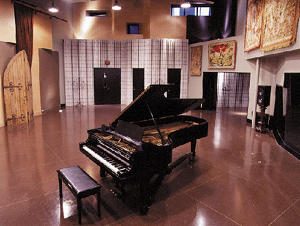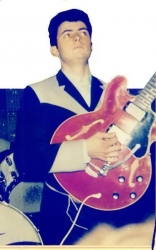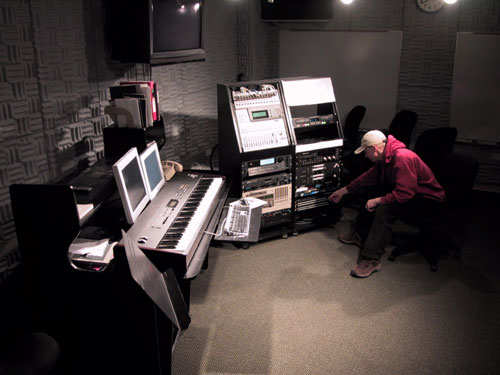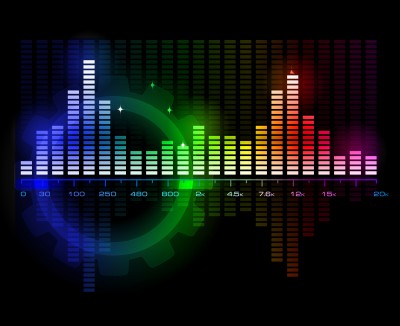The evolution of home music studio
 The rapid development and cheapening of information technologies made the most complex technological processes, previously available only to the elect, to the general public. However, this gave rise to a certain paradox – the highest computing power is often combined with the complete technical illiteracy of users. Powerful computers, which have embodied the many years of work of theorists, engineers, and inventors, often serve as a typewriter and screen for viewing floating fish. But the opposite happens, although much less often – competent, highly professional use of all resources, which brings excellent results. In relation to the home studio, this means not just a good demo tape, but a full-fledged professional product, comparable in quality to the products of medium-budget studios. As a rule, this is achieved by thorough knowledge of the technological and creative depths of the recording process and a long creative search. How to achieve the best results in such a difficult task will be discussed in this article. I do not pretend to compile a complete guide to digital sound recording at home using a computer – such works are more than enough. However, they talk a lot about the basics and very little about how to really achieve high quality in this difficult endeavor. Therefore, I found it necessary to share with the readers some thoughts on this matter.
The rapid development and cheapening of information technologies made the most complex technological processes, previously available only to the elect, to the general public. However, this gave rise to a certain paradox – the highest computing power is often combined with the complete technical illiteracy of users. Powerful computers, which have embodied the many years of work of theorists, engineers, and inventors, often serve as a typewriter and screen for viewing floating fish. But the opposite happens, although much less often – competent, highly professional use of all resources, which brings excellent results. In relation to the home studio, this means not just a good demo tape, but a full-fledged professional product, comparable in quality to the products of medium-budget studios. As a rule, this is achieved by thorough knowledge of the technological and creative depths of the recording process and a long creative search. How to achieve the best results in such a difficult task will be discussed in this article. I do not pretend to compile a complete guide to digital sound recording at home using a computer – such works are more than enough. However, they talk a lot about the basics and very little about how to really achieve high quality in this difficult endeavor. Therefore, I found it necessary to share with the readers some thoughts on this matter.
The first thing is control!
As practice shows, a huge number of errors occur due to shortcomings of monitoring. And this is characteristic not only of home, but also of professional commercial studios – the lack of normal control, especially in the low-frequency domain, leads to gross errors in tonal balance and, as a result, promiscuity, dirt in sound or lack of drive. When planning the budget for a home studio, you need to devote a sufficiently large part of the budget for the purchase of high-quality monitors and, if possible, the necessary acoustic finishing of the room. Even with not very high quality of the rest of the equipment, this will allow a sober look at the results of their work and a true assessment of its quality level. However, not everyone will be pleased – many “figures” of home recording often clutch their heads, listening to their own, made not good news on anything, on normal studio monitors in the far or at least the middle zone.
So, let us assume that, with control, the issue is somehow solved, and the results are still unsatisfactory. What is the matter? And the fact that you need to teach your ears to hear the tonal balance. Concert halls with good acoustics and symphonic or chamber music are the best school for the ears in this difficult task. The quantitative and qualitative composition of the symphony orchestra has been selected for centuries and is a precisely calibrated ratio of instruments. As a rule, several visits are quite enough to dispel the flawed idea of a “good” sound and adjust the perception to the desired mode. The ability to hear is much more important than the ability to turn the knobs.
Best the enemy of the good
“Yes, I have so many effects in my computer – I suppose you want it!” – a very common opinion among beginners. And wrapped it up, wind it so that the ears fade. And then they are surprised that it sounds rather bad in the virtual version (probably, there are few processing, “you need to upgrade to make the plug-ins draw more.” The most frequent mistakes are excessive equalization, excessive compression and porridge-like reverb. As a result, a soapy dynamic mix that you can listen to except on computer multimedia speakers for $ 10 in mp3. In such cases it is best to try to keep the recorded material dry, that is, without using the processing at all. It is very useful practice. And yet – before you turn the hand ki, you need to provide a detailed picture of the sound, find a place in it for each instrument, imagine all the spatial plans.This is not easy, but it helps a lot in further work.
Caution – figure!
Digital methods of work with their apparent ease fraught with a lot of pitfalls. One seemingly insignificant incorrect operation – and suddenly the air disappears somewhere, the transparency. The sound becomes hard and unpleasantly crispy. Simply changing the volume of the file – normalization can irreparably spoil the sound. Therefore, try to keep high (24 bit, and in some cases 32) the width of sound files as long as possible, and when forced down, for example, to burn to CD or DAT, use a dieter.
Transparent as a tear
How to increase the transparency of the mix and improve intelligibility? There are a lot of recipes here.
First, cut off the low frequencies on those sounds that are not factored. It should be remembered that each instrument has its own characteristic formants, affecting which, you can distort, or even depersonalize the timbre of its sound. Of course, there is a compromise between the density and intelligibility of the sound.



